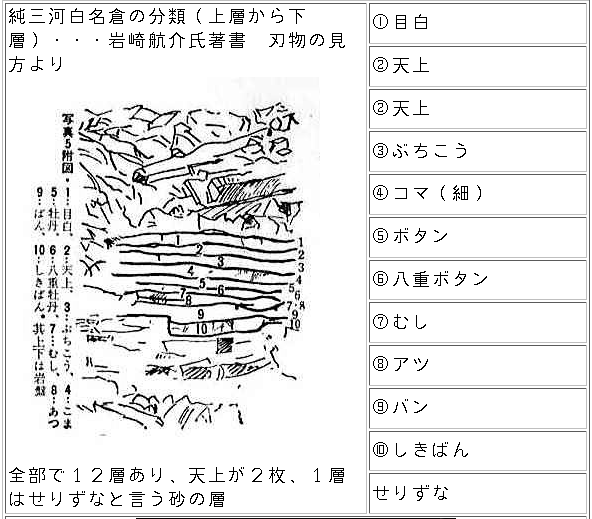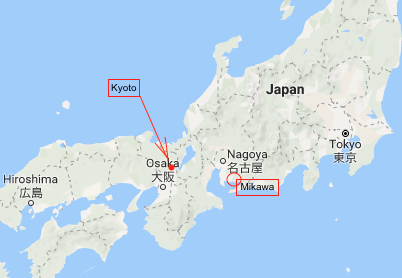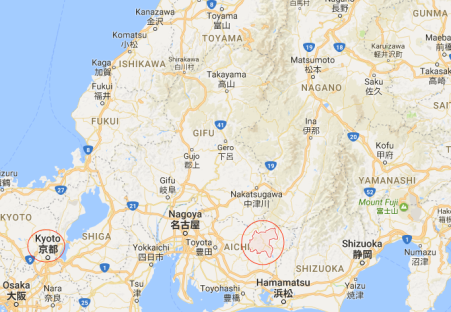Similar to other nagura, these are traditionally used to raise an abrasive slurry on top of a natural whetstone. The difference with Mikawa Asano nagura is the attempt to provide a loose grading system which will allow the user to follow a progression from coarse to fine. These stones are commonly used in a standard bench size with a curved surface for Japanese sword finishers, but for the average person are typically used in a smaller nagura handheld form to hone a razor or more rarely sharpen a knife blade. As a non-sword user, you may still use the bench sized stones in a similar progression, but they will be very expensive.
Origin and Layers
These nagura come from the Junmikawa Shiro mine in the Kitashitara district of Aichi prefecture. There are between 10-12 layers to the mine, depending on the area which was excavated. Of these layers, there are 8 that are usable and 4 that are the most commonly utilized. In areas which have 12 usable layers, there are two different layers of Tenjyo as well as Yae Botan and Botan which are very similar. As with all Japanese natural stones, variations between each individual stone can occur, so some trial and error are always necessary to test if the stones you get actually match the progression expectations. It almost always will. Paying higher prices for other people to vet or “match” the stones is not worth it. For background on why Iwasaki created the progression, check out the Background area at the bottom of this page.
Full Progression
Most Coarse
Mushi [ムシ]
⇩
Ban [バン]
⇩
Atsu [アツ]
⇩
Yae Botan [八重ボタン]
⇩
Botan [ボタン]
⇩
Tenjyo [天上]
⇩
Mejiro [目白]
⇩
Koma [コマ]
Most Fine
Those are all of the layers that one could use, however Mushi & Ban are usually used for tool sharpening such as for scissors or farm equipment. Their rarity and subsequent price likely mean though you would be better off using a synthetic stone for that work and transitioning to your natural nagura and whetstone after you have done most of the reshaping. Atsu can also be used at the start of the progression and is fine enough to start keen bevel work on razors.
Mikawa Chu Nagura
You may see a type of nagura called Chu which is sometimes sold as a Mikawa Chu. Real Chu is not mined from Junmikawa and is instead mined from Kada mountain. As such, is not a Mikawa nagura by how we use the term colloquially (Kada mountain is within the Mikawa mountain range though). Real Chu is typically around the Botan/Tenjyou range in fineness and cutting speed. Often what happens is a Mikawa stockpile of unknown strata is found, tested, and they can tell it is not Koma but are not sure where it falls in the standard lineup besides that. In such a case, they may label it as Mikawa Chu and sell it that way rather than trying to grade it more specifically. This is much more common when dealing with bench sized Mikawa stones versus hand-held stones.
Common Progression
For the average user, the progression with Mikawa nagura will be as follows:
[Course] Botan -> Tenjyo -> Mejiro -> Koma* [Fine] -> Tomo Nagura -> Water Only -> Leather Strop
The grading system was developed long ago between the razor maker Kōsuke Iwasaki and Nagayuki Asano with the goal of trying to standardize nagura grading. It certainly makes for an extremely sharp edge, but there are some debates about whether certain elements are actually courser or finer than others. It is not just about hardness or particle density, but the shape and size of the particles differ from layer to layer and impact how the blade finishes in the end.
*See next section on Koma necessity.
Koma vs Mejiro – Do I need Koma Nagura?
There is an ongoing debate regarding if you need Koma in your progression or if you can finish the Mikawa portion of the progression on Mejiro. In his book, Iwasaki only brings up Koma as a passing topic and doesn’t give any instruction to use it at the end of the progression as is commonly recommended today. When we compare the two, Meijro is generally considered to have similar abrasive fineness to Koma, however Koma tends to be of similar fineness while being a bit faster in its cutting performance.
For those that endorse buying Koma, this is where the benefit of Koma comes in and the “better edge” originates. The Mejiro step is almost a pure polishing step, and before you finish your polishing steps on Tomo Nagura / Water Only / Stroping, Koma gives you the opportunity to ensure any false wire edges are removed through a bit more aggressive but still very fine honing step. Koma is unfortunately very expensive due to its use in sword polishing, so if you are unable to get Koma, more time spent on the Mejiro step before going to the Tomo Nagura step should still make for a great shave. This concept of Koma’s value is entirely erroneous if you are going to use a pasted strop at the end of your process, which will be what is ensuring there are no false edges / wire edges.
Much of this is hard to quantify as it is going to come down to personal opinion.
Mikawa Nagura Grit Ratings
We really should not rate Japanese Natural Stones with a grit, but I get asked it so much I end up doing it anyway with an analogous number. The stones do not perform exactly like the synthetics would, but this will give you a very loose picture:
- Mushi Nagura (x2000)
- Ban Nagura (~x2500)
- Atsu Nagura (~x3000)
- Yae Botan Nagura (~x3500)
- Botan Nagura (~x4000)
- Tenjyo Nagura (~x5000)
- Mejiro Nagura (~x6000)
- Koma Nagura (~x6000)
*Grit ratings are shown for bench-stone sizes where the blade is being used directly on the stone. If used in handheld format, add about 1000-1500 to the number shown.
Do I Need Mikawa Nagura to Hone My Razors?
Do you really need these stones? No. Whether you use synthetic stones or natural stones, the Mikawa Nagura progression could be replaced by a stone progression with appropriate grits. If we use the common Botan -> Tenjyo -> Mejiro -> Awasedo progression, we could instead replace it with something like this:
- Tsushima Nagura Bench Stone (x4000-x5000)
- Tomae/Suita/Aisa/Namito/etc. [Soft 2-3/5] (~x6000-x8000)
- Tomae/Suita/Aisa/Namito/etc. [Medium 4/5] (~x8000-x10000)
- Honyama Mine Tomae/Suita/Aisa/Namito/etc. [Hard 5/5] (~x10000-x12000)
Nothing about the Mikawa Nagura progression is magic. What they do provide is a rating system that the inexperienced user can follow. Being able to know if the sample of Tsushima Nagura or Suita can function as your steps requires guidance or experience, often times luxuries new users do not have. The Mikawa Asano Nagura allow the average person to buy a progression and get fantastic results.
The price per gram has gone up considerably for these Nagura as they become scarce, often competing outright with really nice 4/5 or 5/5 base stones. At such a price, the value of a mikawa nagura is debatable versus spending more time on the stone with a tomo nagura, diamond plate nagura, etc. Only you can decide if you think the Nagura are worth it for you.
My general recommendation for anyone looking to use a nagura progression for knives or razors is to forgo the progression entirely (can be made up for with only a few minutes of more time on the stone) and instead invest in one decent handheld nagura of the Tenjyo or Mejiro layers directly from Sakamoto as his prices are the best.
My Nagura Is Missing a Layer/Strata Designation. What Is It?
Often there are smaller pieces of Mikawa Nagura which may be marked as 释硭用 are given out in smaller sets or as additions to a larger purchase. These will have the Asano stamp and the Mikawa mine stamp on them, but no other strata/layer/use designation stamp. Little Mikawa Nagura like this are often referred to as Ho-Bo and are used traditionally to chamfer off the edges of a stone as it wears down from the use of the main Nagura. Ho-Bo can be from any of the strata layers but are usually from Botan/Tenjyou/Mejiro layers. They are a lot of fun to test out and see what you get from a few of them but will be quite small and assure you no level of specific performance.
If you have a larger Nagura which isn’t marked 释硭用 but still no designation and is marked Mikawa, it is likely a misplaced piece of stock or the strata wasn’t recorded when it was stored – leaving it difficult to stamp properly. It could also be a reject during the evaluation process where it performs too far out of spec for its usual use to be stamped as Botan/Tenjyou/etc. These are almost never marked with the “Asano” stamp, but I felt it was still important to briefly touch on them given their Mikawa origin. Nothing is wrong with these Nagura and they can be used just as well as the rest of them, but it will require you to test it yourself – take care when doing so as you may chip your razor’s edge if it ends up being a coarser version.
Generating Slurry with nagura
As with all Nagura, you can generate slurry one of two ways. The traditional way would be to just rub the Nagura on the surface of your bench stone, which is hopefully harder than your Nagura. This will generate mostly Nagura particle slurry with a bit of base stone slurry.
The second way to do this is to put some water on a finer Atoma diamond plate and rub the Nagura on the diamond plate, generating pure Nagura slurry. This can then be transferred onto the surface of your bench stone to hone with. I prefer this way, as it generates slurry faster and does not scratch your base stone’s surface up.
I prefer the first method as it does not give any opportunities for diamonds to work their way into the mix. If you are having issues, you can condition the surface of the handheld nagura itself and soak it for a while which will increase its friability.
Mikawa Nagura Purchasing
As with almost all Japanese mines, Junmikawashiro has been closed since 1976 with no virgin stone coming out of the ground since its closure. A large amount was pulled out when the mine was open in the 60-70s and is in storage with different wholesalers around Japan. As with all supply and demand, this means that the remaining stock will continue to go up in price.
It is still readily available on the market with not only Mikawa stamps but also the red Asano stamp which means it is checked by Asano. Both Kōsuke Iwasaki and Nagayuki Asano have passed away by now, but Asano passed the well-known stamp onto Sakamoto Misao, who has since passed them along to Sakamoto Morio. As of March 2019, Morio is still the individual stamping new stones with the Asano stamp and grading them. His son Sakamoto Kouji is set to inherit the stamp at his passing so we will continue to see new stones with legitimate stamps coming out onto the market. Of course, this does not mean every stone stamped with the red Asano stamp is legitimate, so make sure to ask sellers questions and buy from reputable ones!
There are unstamped Mikawa Nagura which are available for lesser prices. These pieces are not necessarily of poor or inferior quality, but by nature are more of a gamble. Lacking the stamps it may also be difficult to identify what specific strata these stones belong too, often times buyers have to settle for generalizations between course, middle, fine. I have also heard these are more likely to have harmful or sand inclusions in them, however I do not know this to be fact by experience.
You may find more information about reputable vendors on the following Reputable Japanese Natural Stones (JNAT) & Nagura Sellers page.
You can find more information about the stamps on Mikawa Nagura on the Mikawa Asano Stamps and Glossary page.
Mikawa Nagura Strata Hierarchy
Above we see the different strata the nagura come from in the Junmikawashiro mine. The unusable layers serisuna, buchi, and shikiban are shown in the image.
Above is a hand drawing from Kōsuke Iwasaki’s notebook showing the ten different layers an dhow they were oriented in the ground.
Two maps of Japan outlining the region of Japan where the Junmikawashira mine is located.
Mikawa Nagura Background
Mikawa Nagura (japanstones.com)



